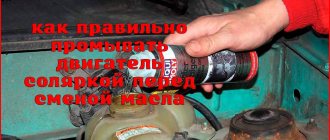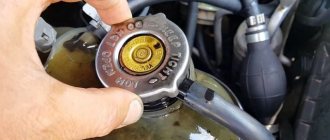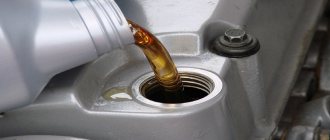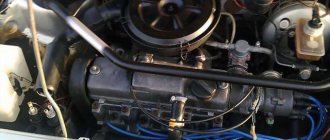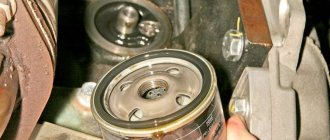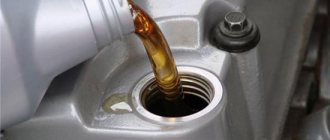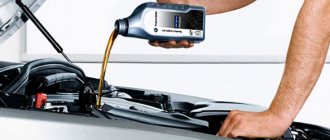Flushing the engine before changing the engine oil is a procedure that drivers carry out for various reasons. The engine is flushed to remove heavy contaminants from the lubrication system, during the transition from one type of oil to another, as a result of malfunctions that intensively contaminate the oil system, etc. Note that there are several ways to clean the internal combustion engine. You can use special flushes into the used oil (the so-called “five-minute flushes”), add flushing oil for a short period of time, or even drive some flushes for several tens of kilometers in moderate mode.
We also recommend reading the article about whether it is worth using a flush before changing the oil. From this article you will learn about cases when this procedure is necessary or may be useful, as well as when it is better to refrain from flushing the engine.
In parallel with this, for many drivers, flushing the engine oil system with diesel fuel remains the preferred option. The main argument is that for such washing there is no need to separately purchase ready-made washing compositions, which saves money. In this article we will look at this cleaning method in more detail, and also talk about the advantages and disadvantages of such a solution.
How to do the flushing?
If earlier this method helped many car enthusiasts, now the time is a little different. Not only car engines change, but also car oils for them. If you decide to flush your new engine with kerosene, keep in mind that you will easily lose the warranty on it. When the engine is dismantled and completely disassembled, then, of course, you simply will not find a better flush than kerosene or diesel fuel.
As for cleaning the internal combustion engine from carbon deposits, coke and lubricating fluid residues, in this case, cleaning the engine from engine oil is doubtful.
Despite the myths that circulate around these flushing agents, they will not be able to completely flush the internal combustion engine, because there are always hard-to-reach places in the system where sediments settle. Thus, diesel fuel will fall into such a zone of the engine and, albeit in small quantities, will remain there. As a result, you will fill in new engine fluid, which will mix with the remaining kerosene. In this case, your car will definitely not thank you.
A clean internal combustion engine - achieved by cleaning with diesel fuel during complete disassembly
If you still decide to flush the unit, then know that this procedure for cleaning the system will be most relevant and painless for owners of classic VAZ models or not new foreign cars. This cannot be said to be very useful, but in practice this procedure really effectively cleans the unit. You will need at least 5 liters of diesel fuel or kerosene. Typically, this process is carried out during an engine fluid change, so you should have a new oil filter.
In general, the procedure includes the following steps:
- flush the engine to operating temperature;
- drain the engine fluid;
- pour prepared kerosene or diesel fuel;
- start the vehicle engine and accelerate;
- turn off the car for a few minutes (it is impossible to allow the internal combustion engine to warm up to operating temperature with kerosene);
- repeat the procedure at least twice;
- drain the used kerosene;
- Replace the filter element and add new engine fluid.
Kerosene as a flushing agent
Step by step instructions
The engine cleaning procedure itself is as follows:
- After draining the oil from the engine, make sure that the same volume of kerosene can fit into the pan where the engine fluid was drained.
- The flushing material itself, in this case flushing or kerosene, must be poured in sharply so that it passes under pressure through all accessible engine components and washes out any remaining oil. The drain plug should be open at this moment. You need to pass about two to three liters of kerosene through the internal combustion engine.
- Then close the drain cap and fill the unit with as much flushing agent as you pour in oil when changing.
- Start the engine and rev it up for a while. Depending on how you gas, the cleaning efficiency of the unit will depend. This must be done so that the pressure increases and the flushing material better cleans all parts. The main thing that needs to be carefully monitored in this process is that the unit does not warm up to operating temperature.
- Drain the flushing material and inspect the fluid visually: if there is a lot of engine fluid residue in it, flush it one or more times.
- When the unit cleaning process is completed and new lubricant is added, start the engine. Let it run for a while so that any remaining cleaning agent used is completely dissolved. Take a test drive just in case.
Flushing the internal combustion engine in this way can have some effect. Firstly, the knocking noise of hydraulic compensators will be reduced. In practice this actually happens. Secondly, the new lubricant poured in will remain transparent much longer. However, it is also possible that after such a procedure problems may arise with starting the unit. Since these flushing agents are not able to provide the desired friction effect, the starter may have problems turning the crankshaft. Or even after cranking the crankshaft, it will put a certain load on the internal combustion engine elements.
Drain the engine oil
Pour kerosene into the engine
Fill with new engine fluid
Power unit flushing products: what to choose
All commercially available compositions intended for cleaning engine parts from carbon dioxide deposits and various slags are divided into 3 groups:
- special flushing oils;
- additives for gentle flushing;
- additives for quick flushing (five-minute liquids).
Flushing oils differ from conventional ones in their less viscous consistency, which allows them to penetrate into all stagnant zones of oil ducts, and in an expanded package of detergent additives. They are made on a mineral and synthetic basis and are sold in canisters with a capacity of 4 and 5 liters. When flushing, this composition completely replaces the previously drained old lubricant and acts for 10-15 minutes with the engine running, after which it is also drained.
Oil change kit with flushing
Using good quality flushing oils is the best cleaning method that gives a positive result and does not harm the parts of the power unit. Well-known brands Liqui Moly and Castrol specialize in the production of such compositions. The disadvantage of this method is the duration of the procedure; you will have to spend at least 1 hour on it, which is important for too busy motorists.
Special chemicals and additives for washing
The most well-known and proven manufacturers of gentle additives are the Hi Gear and Bbf brands, although you can see many liquids of other brands on sale. They are produced in plastic and tin containers with a volume of 400-500 ml and are a mixture of detergent components added to the crankcase during operation. For example, the instructions for the American Hi Gear flush read as follows:
- to clean an engine with low wear, you need to add an additive 200 km before changing the oil at the rate of 1 can per 4-5 liters of engine lubricant;
- In a worn-out engine or with a mileage of over 70 thousand km, you need to fill 2 cans: one 1500-2000 km after changing the oil, the second 200 km before the next one.
Detergent additives Liqui Moly and Runway
Additives in this group are easy to use and quite effective; they are well suited for busy people who do not have time to bother with flushing oils. According to user reviews, engine cleaning fluids do not cause any complaints, except in cases of improper use.
“Five-minute” washes (for example, from the Runway brand) are an aggressive liquid designed for a volume of up to 5 liters of oil and designed to quickly clean the engine. They are used like this:
- After making sure that the level of used lubricant is halfway between the minimum and maximum marks, pour “five minutes” into the engine.
- Start the engine and let it idle without revving for 5 minutes.
- Drain the waste along with the additive, change the filter and fill the crankcase with new lubricant.
This type of flushing is considered the most harmful to the rubbing parts of the power unit and rubber seals, despite the manufacturers’ assurances of the safety of the product. Not only is the liquid quite aggressive, but in such a short time it does not have time to thoroughly flush all the channels. The only plus is ease of use.
About traditional cleaning agents: diesel fuel, gasoline and kerosene, acetone and others
In Soviet times, when the choice of chemicals for car maintenance was very limited, drivers washed power units with various available liquids, including:
- What is the best way to flush the engine before changing the oil?
- diesel fuel;
- kerosene, solvent;
- acetone;
- various oils - “spindle”, transformer, diesel.
The listed drugs served as ingredients for the creation of folk detergents, because it is unacceptable to pour diesel fuel or acetone into the engine in its pure form. Transformer oil was mixed with diesel fuel in a 1:1 ratio or with kerosene (400 ml per 2.5 liters of lubricant). Afterwards, this mixture was poured into the crankcase and allowed to idle for 15-25 minutes. At that time, the recipe worked well.
Modern cars are very different from the old Zhiguli and Volga, where the compression ratio was low, there were no sensors and electronics, and cheap alloys and metals were used for the manufacture of CPGs and valves. For this reason, the use of such mixtures, especially those containing acetone, is unacceptable in all new engines. You can wash engine parts with kerosene or diesel fuel only individually, when the unit is completely disassembled for repair.
Why do you need to flush the engine with diesel fuel?
As already mentioned, there is controversy surrounding the question “Should I or should I not flush the engine before changing the oil?” are still ongoing today. Some believe that if the car is new or you are its first owner (that is, you are sure what was poured into it and when), then flushing is not necessary, it is enough to simply change the oil on time and use high-quality products.
Others recommend doing this periodically, arguing this fact by the accumulation of harmful substances, which are mixed with freshly poured clean oil each time. Also, it is recommended to flush the engine before changing the oil when very little time has passed since the last change, and it is already dirty again (you can tell by looking at the dipstick or under the oil filler cap), or when switching from one brand to another.
Now let's figure out what flushing the engine with diesel fuel will give us. Many modern car enthusiasts consider the use of such a tool to be a relic of the past and do not recommend using the old grandfather’s method. But in practice, it turns out that diesel fuel perfectly cleans all internal channels and engine parts, and also has some lubricating properties.
Why then shouldn’t it be used to clean the engine? Here's why... Diesel oil is not a flushing material, it is flammable and is intended for completely different purposes.
We recommend: How to replace the instrument panel lamps on a Lada yourself?
Perhaps some drivers are able to remove a certain part of the dirt with its help, but it is by no means possible to say that it is 100% effective in this matter, since even the use of products specially designed for this purpose does not always give a positive result the first time .
In addition, you may come across a low-quality product, the components of which not only will not clean the parts, but will also additionally contaminate the hidden cavities, the consequences of which you will be able to feel a little later (the oil seal will swell or the engine itself will begin to wear out more).
There is also an opinion that diesel fuel (“five minutes” too, by the way) flows into the sump and clogs the oil receiver mesh, thereby adding to problems with the engine.
In general, to summarize all of the above, it can be noted that it is possible to wash individual parts and components of the engine with diesel fuel when it is in a disassembled state, but doing the same by pouring it into the system before changing the oil is very undesirable.
Differences in flushing gasoline and diesel engines
Diesel engines differ from their gasoline counterparts not only in design, but also in the features of the flushing process and the materials used for this purpose. To wash them, only special products are used: ordinary “five-minute” and “long-lasting” washes and other compounds used to clean gasoline engines will not only not be suitable in this case, but will also cause irreparable harm.
The oil pump supplies an insufficient amount of oil for the full functioning of the diesel engine. This leads to the need to create a so-called oil wedge, when the rubbing parts of the engine go into a “floating” state. The use of detergent additives, “five minutes” and regular oil when flushing can lead to increased friction between parts. Adding such solutions dilutes the engine oil, causing it to lose all its properties. The deposits that accumulate on the engine walls can vary in composition, so each of them requires a special composition to dissolve.
Therefore, when flushing a diesel engine, experts advise car owners to go to a specialized store and purchase compounds intended for power units of this type. In all other respects, the process of cleaning the engine is no different from that carried out with a gasoline engine.
Flushing the engine with kerosene (diesel oil) - benefits and harms
True, similar methods were used and were relevant several decades ago, since the number of car service points was extremely low. Currently, modern cleaning technologies are equipped with computer devices, which allow you to quickly and accurately flush the internal combustion engine.
Today, the method of flushing the engine with these compounds is becoming a thing of the past, since in addition to the benefits of the procedure, you can also get harm.
Over time, engine designs and lubricants for automobiles undergo constant changes. If the driver nevertheless decides to wash the new power unit with kerosene or diesel fuel, then he will immediately say goodbye to its warranty.
The only rational option for such washing is considered to be a situation where the power device is completely dismantled and disassembled in parts.
Despite the legends that surround these oil flushing products, they will not completely cope with the task. The engine system always contains hard-to-reach areas where contaminants are densely located.
Therefore, if kerosene penetrates into this area, even in small quantities, the oil product will remain there. And this is fraught with consequences.
If the owner of the car fills in a new portion of the lubricating mixture, the remaining kerosene will be mixed with this motor fluid. As a result, the lubricant will lose some of its beneficial properties.
The best flush for the engine cooling system
Flushing with water is well suited for the internal combustion engine cooling system. This method allows you to solve the problem quickly and at minimal cost.
It is recommended to use distilled water as it does not contain any aggressive substances that can damage rubber parts. This method is effective only in cases where the contamination is negligible.
The use of acids is more effective. This option involves the use of citric or phosphoric acid, which are diluted in distilled water in a proportion of 100 g per 1 liter.
Liquid poured into the cooling system remains there for at least three quarters of an hour. This procedure should be preceded by flushing with plain water, which is repeated after draining the acid from the system. The final rinse with water involves 4-5 full cycles to completely neutralize the acidic environment.
Car enthusiasts often resort to washing with a bite. In this case, an aqueous solution is formed in a proportion of 1 to 10. In order for the cleaning agent to function well, after pouring the solution into its system, it is heated to approximately 100 degrees Celsius.
After this, it is left in the system for about 10 hours. If, when draining the solution, there is no dirt and/or scale in it, then there was not enough time and the procedure should be repeated.
Washing with soda also finds its use, but exclusively for cleaning engine elements made of copper and/or brass. For these purposes, 50 grams of soda are diluted in a liter of plain water. This composition is cheap, but does the job perfectly.
Features of the washing procedure
The main reason for washing the engine with diesel fuel is to completely cleanse the internal combustion engine of past lubricant and contaminants. Often, liquids are used for cleaning that can dissolve solids, resin and old oil residues. Usually, special additives are added to the car oil before draining. You can also fill in the flushing agent after draining the used consumables. Today's flushes perform their task well, but they are expensive and considered quite aggressive. If they are added to the engine, they can destroy its parts.
Frequent oil changes, better than flushing
Diesel has long been used by those who needed to flush the engine. In the past, it was the most effective flush of all. Diesel oil perfectly dissolves resin and old grease residues. It is fluid, and when passing through the oil channels, it dissolves slag, carbon deposits, and clots of motor oil, and removes them from the power unit. In terms of its own cleaning characteristics, diesel can adequately compete with special products that wash the engine. At the same time, it does not harm metal elements, linings and seals. The reliability of flushing the internal combustion engine with diesel has been tested over decades of operation of cars of different models.
Experienced drivers who clean the engine with diesel fuel advise mixing it with motor oil. A similar mixture is obtained by mixing the same amount of diesel and lubricant.
Carrying out the filling procedure
The engine is flushed with diesel fuel after draining the used oil. This draining is carried out in the standard way through a hole in the oil pan. To do this, the car is installed on an inspection hole or overpass. Using the appropriate wrench, loosen the drain plug. After a container is placed under it, the plug is unscrewed by hand and sharply pulled to the side so that the oil stream is directed into the container. Used oil must be completely drained from the system.
The next step is to remove the oil filter, which is usually unscrewed by hand. If necessary, the appropriate key is used. After this, a temporary oil filter is installed. It is only needed for the engine cleaning period, so it is recommended to choose the cheapest option.
The washing procedure is carried out in two stages. First, when the plug is removed from the drain hole of the oil pan, diesel fuel (a mixture of diesel fuel with oil or kerosene) is poured into the system with a sharp movement. The initial impulse of the priming jet is necessary to ensure gravity flow of the liquid throughout the system. The volume of diesel fuel poured is about 2.5-3.5 liters. The cleaner should pass through the oil system and flow out of the drain hole at the bottom. This ensures primary cleaning of the largest contaminants and residues of the old composition.
The next stage of washing is carried out with the plug closed, for which it is returned to its place and tightened manually. Diesel fuel is poured into the lubrication system in a volume equal to the usual amount of oil poured. After this, you need to start the car engine for a short time and drive it in the gas mode. The degree of cleaning of the system largely depends on this engine gas release
It is important to control the temperature - the engine should not warm up to operating temperature
The engine is turned off and the drain plug is unscrewed again. All filled diesel fuel is drained while controlling the release of dirt. If pieces of dirt continue to come out along with the last drops of solvent, then the flushing operation is performed again (with the engine running). Similar procedures are carried out the required number of times. The duration is determined by the type of diesel fuel being drained.
Flushing stops when clean, transparent liquid begins to flow from the drain hole.
How to properly wash a car engine with your own hands
The engine flushing operation is completed by completely draining the flushing fluid. After which the drain plug is tightly screwed in with a key. The temporary oil filter is dismantled and a new high-quality oil filter is manually screwed in its place for operation under operating conditions. After all the manipulations have been completed, you can safely fill in new oil. Naturally, after filling in the new composition, it is necessary to carefully check the tightness of the entire system, and then carry out a test drive in the car.
Bottom line and is it possible to flush the engine with diesel fuel?
From the confirmed information in the material, it becomes clear that flushing the engine using diesel fuel is not suitable for every car. With modern cars, it will be more useful to use more advanced means rather than relying on the “old-fashioned” method. As for the moment of cleaning with diesel fuel, take into account the specific composition of the product being poured, and also pre-assess the condition of your own engine. The answer to how to properly clean an engine using diesel fuel is in the following material.
Let's sum it up
Diesel oil has been used by car owners for many decades as an effective and gentle means for washing the power unit. Today, the effectiveness of the diesel fuel flushing procedure is questioned by many automakers and service center employees; alternatives are considered to be the use of specific liquids to clean the engine. However, a detailed study of the composition of special emulsions for washing the engine raises doubts and controversial issues, since effective removal of soot and dirt using special liquids is achieved due to the presence of aggressive chemical components in them, which can also negatively affect the unit components.
As many years of practice have proven, the method of flushing the engine with diesel fuel has a right to exist, is characterized by high efficiency against the backdrop of low costs, and is considered a gentle way to clean the engine. Each car owner has the right to decide independently which product to choose; however, when performing the flushing, you should act very carefully, follow the instructions, do not overheat the engine - and the result will live up to expectations. Better yet, keep an eye on the engine of your car, try to avoid overheating and stress, change the oil in a timely manner - and the engine will not need such procedures.
Possible consequences - the result is not always expected
Indeed, you can clean the engine very quickly with flushing liquid. But with some motors, after a short time, strange things begin to happen. The level is normal, but there is no pressure. If you continue to use it, the engine may completely fail, which has happened to some. Disassembly reveals heavy deposits, contamination, the oil intake screen is clogged with a viscous resinous substance.
Sometimes it is possible to resuscitate an engine without replacing parts - it is simply washed and reassembled. It happens that the consequences are very serious; first of all, the cylinder head suffers: the camshaft is worn out. There was practically no lubricant reaching the head parts; they were starved of oil. It has already been noted that the oil intake screen was clogged. Why did this happen, since the engine was washed and clean oil was filled in?
To create flushing fluids, the cheapest mineral oils with low lubricity are used
It should be noted that this happens, as a rule, with engines into which low-quality oil was constantly poured; the replacement interval was not observed. They have a good mileage, but the operating conditions are difficult. All of them individually and together led to failure after washing. Sediments, collecting primarily in the pan, accumulate over the years. They adhere tightly to the metal and do not pose a threat in themselves.
When the flushing liquid enters the pan, it actively dissolves deposits, but the allotted time is not enough. The deposits do not dissolve completely, the flushing fluid is drained, and liquid resinous dirt remains in the crankcase. Clean oil is poured in, which dilutes the soaked deposits and spreads them throughout the engine. Soon the central line of the lubrication system and the oil pump filter become clogged. There is enough oil, but it does not flow to the oil pump, camshaft, or CPG parts.
What to wash with?
Clogged lid
Motor oils contain additives with detergent, anti-corrosion, antioxidant, and extreme pressure properties. They are not prone to the formation of deposits and dirt. Many of them are retained by the filter, and some are discharged through the crankcase drain hole. Deposits accumulate if different brands of oil are used.
That is, the remaining contaminants, mixing with the engine oil, precipitate, forming deposits. Frequent overheating of the engine leads to the formation of these, causing decomposition of the motor fluid. As a result, coke deposits that are difficult to wash off and sometimes cannot be removed appear on the inner walls of the block. The situation comes down to the rapid depletion of the lubricant life.
What's better
GZox Flushing Oil
It is preferable to use flushing fluids for the engine. Their range differs in additive components.
- FlushOil− is poured after draining the waste. It is recommended to operate the car for 50÷500 km before filling with new oil.
- EngineFlush− is used after removing the old one. Can be added to the oil in the pan. It is advisable to let the machine idle for a few minutes.
- Cleaning additives are poured into the engine 3-4 days before replacement. They have the ability to penetrate everywhere, splitting and dissolving sludge and slag.
Result of using flushing fluid
Meanwhile, there is no consensus regarding flushing oils. Doubts are raised by aggressive (alkaline) additives, which unsatisfactorily clean coked deposits of dirt within a few minutes of engine operation. And aggressive compounds lead to corrosion of rubber seals.
Flushing the engine with diesel fuel
The car drove 120 thousand and began to eat up oil (up to 1 liter per 1000 km). Compression in all pots is 12.5. Nothing is leaking anywhere. The exhaust is normal.
It was decided to first resort to budgetary methods to restore performance characteristics. To begin with, we decarbonized the rings twice using LAVR. The situation has improved slightly, consumption has decreased, but not enough (about 500 ml per 1000 km).
We recommend: Replacing the heater radiator on a Lada Kalina with your own hands
After thinking and reading materials on the Internet, we decided to test the hypothesis with coked oil scraper rings, which LAVR could not reach due to the fact that it was buried in the cylinders through spark plug wells. We decided to wash from below.
We drained the used oil and washed it with clean diesel fuel by gravity, without starting the engine. The solarium was the same color as a waste product.
Next, we drained 6 liters of the mixture (solar - flushing oil 1:1) and poured it into the engine for 1 hour, turning the crankshaft by hand several times. They started the engine and let it warm up to 40 degrees. They drained it, the liquid was again the color of waste. In addition, dark-colored crumbs were found at the bottom of the basin; the particle size reached 1 mm in thickness and 3 mm in length. The particles were not magnetic. These were probably fragments of “muck” that prevented the oil scraper rings from doing their job. When the trigger was pressed, white smoke came out of the chimney and soot flew.
The procedure was repeated 2 more times. Each time the liquid that was drained was dirty, but each time it became cleaner.
And finally, we washed it with flushing oil, letting the engine run for about 10 minutes. The oil that came out was slightly lighter than the dark Velkopopovets goat.
We changed the filter and filled it with Motul 5w40. So far the flight is normal. I drove 200 km, the level has not changed yet.
Consumables and related tools: 15 liters of diesel fuel 8 liters of flushing oil (if you repeat, take 12 liters, we didn’t have enough oil for the last body of water for a 1:1 ratio, so we used 1 liter of oil for 3 liters of diesel fuel) 2 oil filters 3.5 liters of synthetic motor oil 6 liters of foamy drink 4 hands 2 heads
At the same time, we also changed the A/C radiator and cleaned the cooling radiator of accumulated fur coats.
PS 10 km after the procedure, the engine started working, it turned out that when flushing the radiator, two spark plug wells and the coils in them were filled with water. When replacing the spark plugs, it turned out that the spark plugs had a fair amount of soot on them (the same as in the exhaust during flushing). Therefore, after carrying out the above procedure, replace the spark plugs. PPS The car is catalytic-free and has a flame arrester. Chipovana. I’m afraid to imagine how this procedure could affect the catalyst, proceed at your own peril and risk. The desired result was achieved; large investments in engine overhaul/replacement were avoided.
Let's weigh the pros and cons
Of course, since you are reading the article, you are a caring owner. And at a minimum, try to extend the life of your engine - this will save money in the future on buying a new car or replacing an old one. But is the washing process really necessary? Will it do any harm?
Cases when major cleaning is necessary:
- The motor has considerable mileage. During long-term uninterrupted operation, clots consisting of tarry deposits, scale on the walls, and slag accumulate inside the power unit. The longer a car is used, the more consumables it has. If you want to extend its life, then rinse it.
- If you don’t know what’s in the box and don’t want to risk mixing possibly incompatible liquids
- In cases of change of manufacturers or types of fuels and lubricants. Without flushing, at best, you will get a lubricant with average properties that will behave unpredictably under extreme conditions. At worst, a breakdown of the lubrication system or the internal combustion engine as a whole.
- If there is a suspicion that cooling components have gotten into the oil when using the car. As a result of breakdowns of individual components.
- After a major overhaul of the “heart”. Due to such work, small particles of used lubricants or scattered scale may remain inside. Without flushing, they will worsen the passage of lubricant through the channels intended for this purpose.
- Using the machine for a long time under extreme conditions: low or high temperatures outside, high speeds, dusty or polluted operating environment
- Inside is a turbocharged engine, which is especially sensitive to dirty lubricant and can be seriously damaged. For such models, a “major bath” is required much more often - every 3-5 thousand km.
Positive effect and possible negative consequences
Diesel fuel has excellent dispersing ability. That is, it dissolves even old deposits of various natures, including sludge. Therefore, many motorists 20-30 years ago actively used diesel fuel as a liquid for flushing engines. That is, in those days when engine parts were massive with an impressive margin of safety and minimal requirements for fuels and lubricants.
In addition, some diesel fuel, which will certainly remain in the engine crankcase, will not have a pronounced negative effect on the new oil. After flushing the engine with diesel fuel, it is not necessary to somehow expel the remaining diesel fuel from the crankcase or to fill and drain fresh oil several times.
This method of cleaning the motor is also relatively inexpensive. Compared with cleaning agents, and even more so with specialized oils, washing the engine with diesel fuel will be several times cheaper.
This is where the positive aspects of this procedure end. Let's briefly look at the possible negative consequences.
- Lumpy detachment of solid deposits. Sludge build-up accumulates on static surfaces in many motors. Diesel oil can simply separate them from the surface and dump them into a pan. Or run it into the oil channel. Which will cause partial or complete blockage and oil starvation of any friction pair.
- Negative impact on rubber (caoutchouc) and plastic parts. The vast majority of modern seals and retainers in engines made of plastic and rubber are resistant to the chemical effects of any petroleum products. But diesel fuel can completely destroy “tired” non-metallic parts.
- Possible damage to the liners and the formation of scuffing in the ring-cylinder friction pairs. Diesel fuel does not have sufficient viscosity to create any strong protective layer.
All these consequences have the status of probable. And they will not necessarily occur in every individual case.
In what cases should you absolutely not wash your engine with diesel fuel?
There are two cases in which flushing the engine with diesel fuel before changing the oil is more likely to have a negative rather than a positive effect.
- A very tired engine with a lot of output. It is not without reason that some car operating instructions say that after a certain operating time (when the engine wears out and all the gaps in it increase), it is advisable to start filling in thicker oil. This is done to compensate for gaps due to the thicker and more durable oil film created by thick oil. Diesel fuel has a very low viscosity. And even with its short-term use, metal-to-metal contact in all loaded friction pairs will be irreversible. The result is accelerated wear to the limit and a high probability of jamming.
- Modern technological engines. There is no question of using regular oil with the wrong viscosity. And using diesel fuel as a flush at a minimum (even with a single fill) will significantly reduce the service life of the motor.
It is theoretically possible to use diesel fuel as a flushing fluid on engines that are primitive by modern standards (old non-turbocharged diesel engines, VAZ classics, outdated foreign cars).
Reasons for flushing
Flushing the engine with kerosene or diesel fuel has long been considered a well-known and old method among domestic motorists. In addition, this topic constantly gives rise to many questions and disputes. Not only in life, but also on the Internet, car enthusiasts often actively argue about flushing the internal combustion engine with these products. But no one can give a definite answer.
Carbon deposits on the internal walls of the internal combustion engine
So, what are the reasons for flushing the engine with diesel fuel before changing the oil? Diesel fuel or kerosene is an excellent tool that allows you to replace special cleaning materials. Flushing with diesel fuel or kerosene allows you to restore the internal components of the internal combustion engine to their former youth. This opinion exists among car enthusiasts of the old school. These people believe that kerosene or diesel fuel provides excellent engine cleaning. These substances make it possible to dissolve carbon deposits and toxins, clean the channels through which engine oil circulates, and eliminate dirt collected there. Thus, flushing the internal combustion engine with kerosene or diesel fuel, according to experienced motorists, can increase the service life of lubricating systems.
But is this really so? Such methods were relevant in those days when car service stations were not so common, and the services of specialists were available only to a few motorists. And for such an opinion to cease to exist among our drivers, more than one generation must change and many years must pass. Nowadays, when modern vehicles are equipped with computer systems, flushing the engine with diesel fuel or kerosene can be compared to alternative medicine. That is, it may not do so much good as harm.
Carbon deposits on the inner walls of the engine
Reviews from motorists who have tried the diesel fuel flushing method
Good reviews about the method of washing an engine with diesel fuel are mainly left by owners of outdated equipment. For example, drivers often wash ZMZ and VAZ engines with diesel fuel. Here, in most cases, there are no pronounced negative consequences. Although it is not a fact that in one wash the car owner did not reduce the engine life of thousands by 50 km.
You can also find negative reviews on the Internet. For example, after filling with diesel fuel, the engine seized. After disassembly, worn out and twisted liners were discovered.
Therefore, the conclusion about this method of cleaning the engine is this: you can use diesel fuel, but carefully and only on well-preserved outdated engines.
Modern service – is it worth experimenting?
A huge number of service stations, as well as special oil change points, can provide any car owner with quality service with a selection of individual products. To do this, you will not need to bother with the problem of draining the used oil and the method of filling it to replace it.
Also, most likely, the service staff will offer to wash the engine with special detergents, but this is not necessary and only you decide whether to do this or not. Of course, all these services cost money, but the desire to save money can turn against you.
We recommend: Instructions for reupholstering car seats with your own hands
During the Soviet Union, when cars were just beginning to be widely used, there was nothing like this. Each owner, in separate garages, independently maintained and repaired his car, often using improvised means. It was from that time that the fashion of washing the engine with diesel fuel, and not only that, began. Kerosene or solvent was also used for these purposes.
Nowadays, when there are a huge number of tools specifically designed for this, using grandfather’s methods is simply illogical; why complicate life for yourself and your car. Also, one cannot be completely confident in the positive reaction of modern machines to such manipulations.
Maybe representatives of the VAZ-ZAZ era withstood various “bullies” of their owners, after which they even worked properly for some time, but today’s foreign cars, with their electronics and more advanced systems, will definitely not thank you after committing such actions.
And our grandfathers had no other choice; the quality of the same motor oil, which is used today by individual motorists for flushing, then left much to be desired, so we had to use kerosene and diesel fuel. If any foreigner knew that a similar trend is still used somewhere, he probably wouldn’t believe it. But this is true, although most drivers consider this method of cleaning the internal space of the engine to be an unjustified risk.
Thus, we came to the conclusion that in our time it is better NOT TO EXPERIMENT and trust existing technologies.
How to flush the engine: oil compounds, cleaners and other chemicals
Today, when changing the oil or carrying out complex repairs, they resort to four main methods of flushing the engine:
- Flushing oil. A special product that is poured into the engine after draining the old used oil. With this composition, the car is operated in a gentle manner for several days. This option is not the most popular, since it requires additional investment and time: for three to four days you need to visit a service station almost every day, pay for the work of specialists and at the same time observe a gentle driving regime.
The simplest and most cost-effective way to keep your car engine in working condition is to regularly change the oil and oil filter.
Liqui Moly flushing oil
Liqui Moly is one of the most common and popular engine flushing products available in a wide range.
Oilsystem Spulung
Oilsystem Spulung is a cleaning agent that can be used to clean the internal combustion engine and oil system.
The most effective result is achieved when used in vehicles that operate:
- in aggressive and hard driving conditions;
- in regular traffic jams;
- in case of untimely replacement of engine oil.
Separately, it is worth noting that this type of Liqui Moly cleaner can be used for both gasoline and diesel power units. Regular use of the composition allows you to extend the life of the motor and keep its parts and components clean. The manufacturer guarantees the following benefits:
- The composition gently dissolves deposits and contaminants embedded in the engine walls without clogging oil filters and pipes.
- Extends the service life of the filled motor oil.
- Additives added to the flushing oil not only clean the engine, but also form a protective film on its walls, reducing friction of parts.
- The composition includes additional additives that protect rubber parts from wear and corrosion.
- Completely exits the system after flushing is completed.
Oilsystem Spulung High Performance
Available in two versions: for gasoline and diesel engines.
Experts recommend using this flush when the car engine encounters the following problems:
- motor overheating;
- power reduction;
- loss of compression;
- untimely replacement of engine oil;
- use of low-quality gasoline or diesel fuel.
The advantages of flushing oil include:
- Quick cleaning of the entire system.
- Neutrality in relation to various materials, including aluminum and rubber, often used in the internal combustion engine system.
- The oil has an absolutely harmless composition that does not react with other substances.
- Oil does not pollute the environment.
Oil-Schlamm-Spulug
Liqui Moly flushing liquid, created to clean an internal combustion engine from sludge, the causes of which are:
- rare replacement of lubricant;
- frequent and prolonged engine overheating;
- moisture or condensation entering the system;
- use of low-quality oils and fuel.
The manufacturer guarantees that the use of such additives reduces engine noise and eliminates the knocking of hydraulic compensators.
It is most effective and expedient to use such a washing liquid in cars whose mileage has exceeded 100 thousand kilometers. The advantages of the composition include:
- Elimination of carbon deposits and black deposits on the oil system pipes.
- Elimination of sediments accumulating on engine pistons, especially on ring parts.
- Cleaning valves and openings of the oil system.
- Cleaning the engine walls from varnish deposits.
- Prevention of oil starvation and costly repairs in the future.
Pro-Line Motorspulung
Cleaning liquid from Liqui Moly, which contains additives that quickly and effectively eliminate contaminants located in the most inaccessible places of the oil system. At the same time, the liquid helps remove carbon deposits accumulated in the piston group. Pro-Line Motorspulung is often used to clean a manual transmission.
How to flush an engine with kerosene or diesel fuel
If the car owner, despite all the recommendations, decided to carry out his plan, that is, clean the engine, then it is important to know that the most painless washing will be for owners of the domestic automobile industry and used foreign cars.
The procedure is not very useful, but it is possible to achieve cleanliness in the internal combustion engine. To carry out the operation, you should stock up on at least 5 liters of kerosene or diesel fuel.
It is more rational to wash with these means during the period of replacing the lubricant mixture. Therefore, it is worth stocking up on a new filter element in advance.
The washing operation includes a number of sequential actions:
- bring the engine to operating temperature;
- get rid of the old technical fluid;
- introduce a flushing component (kerosene/diesel);
- start the engine, accelerate a little;
- turn off the car for 5 minutes so that the system cools down a little;
- repeat the steps several times;
- get rid of flushing components in the system.
After all these manipulations, all that remains is to change the oil filter and add a fresh lubricant mixture.
When flushing an internal combustion engine with diesel, it is necessary to take into account a small nuance. Diesel oil is not as thick as lubricant and is unable to provide the necessary adhesion for spare parts. Due to this, the engine may not start on the first try when washing. There's nothing wrong with that, that's how it should be. Just try to start your own vehicle's powertrain again.
Now drivers can use different flushes to clean the internal combustion engine of the car, but they are quite aggressive. Flushing the engine with diesel is considered much gentler. This method has been used for many years and has proven its effectiveness.
Someone might think that washing an internal combustion engine with diesel fuel is only possible if the unit is diesel. This is wrong. It doesn't matter what type of engine it is. Diesel oil washes engines of any type equally effectively, without damaging the engine parts.
Helpful tips when using flushing oil
What flushing oil to use for the engine, how to choose it - this is a purely individual decision
The basic principles to pay attention to are described above.
Experts advise paying attention to the following points:
- if the history of pouring technical fluids into a car engine is not known, then it is best to use flushing;
- the use of five minutes is extremely undesirable;
- the use of flushing compounds is absolutely not necessary if the car
- it has been used recently, and all recommendations for changing technical fluid are followed.
Service technicians also recommend flushing the power unit as follows:
- On a used vehicle, the engine is flushed.
- A fresh engine compound is poured in, and the car uses it to cover a mileage of 1 to 2 thousand km.
- The waste is removed from the engine compartments; fresh is refilled again.
- The next change occurs after 4-5 thousand km. And so on until the draining oil is normal.
Such step-by-step washing always brings results. Because it is less aggressive and gradually peels off the dirt stuck to the walls. Of course, this comes with financial costs, but it is much cheaper than buying a new engine.
The car owner can always consult at the station on how to remove oil from a car engine or how to use flushing oil. But it’s better to entrust the car to the experts.
Didn't find the information you are looking for? on our forum.
Advantages of flushing the engine with diesel fuel before changing the oil
There are a huge number of pros and cons of such a product, thanks to which fans of this cleaning method always find a reason to argue with the enemies of the “old-fashioned method”. You should start with the beneficial properties of diesel fuel. As many people know, this substance was intended primarily as a type of fuel, and its “cleaning” agents were discovered a little later.
The main quality of diesel fuel is its ability to lubricate the channels and inflows of the engine. In addition to the presence of “cleaning” components in its composition, which corrode deposits (sludge, plaque, and so on), diesel fuel is also enriched with a large amount of sulfur, which has good lubricating properties.
Oil requirements
Based on what was written above, let’s compare what properties the oils of these engines need, starting with diesel:
- Inside a diesel engine, oxidation processes occur faster than its gasoline counterpart, which is caused by a high thermal load and an increased compression ratio. The diesel fuel inside the cylinders does not burn out completely, which means that a lot of unburnt substances appear (the diesel fuel itself, soot, etc.).
- In addition, due to the high degree of compression, part of the exhaust gases and the remains of unburned substances enter the engine crankcase, seeping through the piston rings, they mix with the oil and contaminate it.
- Let's consider the composition of diesel fuel itself; it contains sulfur compounds, many times more of these compounds than in gasoline. When burned, these compounds turn into sulfur oxides, and these oxides are very aggressive, they destroy the metal.
- The situation is aggravated by the ratio of air to fuel. A diesel engine requires more air in the mixture, this causes more oxidation, and the concentration of carbon leads to additional carbon deposits inside.
- I would like to note that maintenance is prescribed for a diesel engine more often than for its gasoline counterpart, and filter replacement is also required.
Let me summarize the requirements for diesel lubricants. To ensure long-term operation of a diesel engine, they need to:
- Protected metal from oxidation products.
- They washed away the soot, preventing it from depositing in the cylinders.
- Withstands high temperatures and pressure.
Diesel oils contain more alkalis and are more resistant to oxidation. There are also other useful additives that play their role. The composition and formula are kept secret by the manufacturers.
Properties required by a gasoline unit:
- Inside gasoline engines, the fuel mixture burns with virtually no soot. Gasoline contains significantly fewer sulfur compounds compared to diesel fuel.
- This means that additives to the oil of gasoline engines contain active components that remove soot. The base number is also reduced; the lubricant of this motor is subject to oxidation much less.
- It is also taken into account that the speed of a gasoline engine is higher, which means that the oil will contain additives that improve the protection of loaded parts at higher speeds. The oil needs to provide increased dynamic and kinematic viscosity under these conditions.
Results for the gasoline engine:
- Less emphasis is placed on protection against oxidation and soot.
- More emphasis is placed on maintaining properties at high rotation speeds.
- Withstands lower temperatures and pressures.
Engine flushing - necessity or impracticality
Flushing the engine with diesel fuel before changing the oil was used by many car enthusiasts in Soviet times and later. Now that special means have appeared, this method is used less frequently, but it still remains popular. The need to remove residual old oil and contaminants arises, and this is done:
- for preventive purposes;
- when switching to another type of oil;
- when I had to mix different oils;
- when the mileage between lubricant changes is significantly exceeded;
- when the owner changes, when it is not known what was previously flooded.
When washing the unit with diesel fuel, one small nuance should be taken into account. Unlike oil, diesel fuel is less viscous and does not provide the necessary adhesion to parts. When starting the engine during the flushing process, minor problems with starting are possible - it may not start the first time.
Nowadays, various flushing compounds are offered for cleaning a car engine, but they are quite aggressive. A much gentler method is to wash the unit using diesel fuel. This method has been used for decades and has proven its effectiveness.
When to rinse
- Buying a used car. When purchasing a car whose service history is unknown to you (carbon deposits and sludge have accumulated in the engine), it makes sense to replace it with an engine flush. Use a stepwise method: first flush the engine with flushing oil, and then fill in with a simple engine oil, but which must correspond to your engine according to SAE and API classifications. Make the next replacement after 1-2 thousand km.
- Switch to another type of oil. If you decide to switch, for example, from mineral water to synthetic, it is recommended to flush the engine, since mixing different types of oils can cause sediment and deposits, which subsequently clog the oil passages.
- Emergency situations. The engine is flushed if you have had to mix motor oils, use oil of unknown origin, or there is a suspicion that it is a fake.
- Transfer to another class. When switching to oil of a higher class (according to SAE or API classification), it is also necessary to flush the engine.
Flushing is not required if you are the only owner and have changed the same oil regularly and on time.
Advantages and disadvantages of different methods of cleaning the engine
The least damage to the engine is caused by flushing with oils with an optimal package of detergent additives, which is the main advantage of this method. If you use it, you will be calm about the technical condition of the CPG and the integrity of all seals. The technique can be improved by purchasing an intermediate oil filter and installing it while the engine is running on detergent lubricant.
The disadvantage of this method is the duration of the process and the relatively high price that will have to be paid for high-quality washing. Therefore, it is practiced in cases where the owner of the car has the time and conditions to replace lubricants with his own hands.
When flushing with oil, fill twice
When there is a catastrophic lack of time, and the lubricant needs to be replaced immediately, there is only one option left - to flush the engine with a quick “five-minute” wash. There is a risk of damage to rubber products, especially if the method is used constantly. In terms of speed and price, this is the most acceptable method, but it is also the most harmful to the engine.
The golden mean is gentle washing. It is not as aggressive as the “five-minute” and will not take up much of your time. The main thing is to be smart about changing the engine oil after filling it, so as not to drive it for too long.
Means for decoking piston rings
When talking about servicing the power unit, one cannot fail to mention the decarbonization operation. It is performed on heavily worn engines, where oil scraper rings and sometimes compression rings are deposited due to carbon deposits. Then the car loses power and smokes heavily, making it impossible to drive. To release the rings and remove carbon deposits, a caustic compound called a decarbonizer is injected into each cylinder. This procedure must be combined with an oil change, otherwise the aggressive liquid can damage the seals or corrode the gaskets.
Video: Decoking of rings with washing
Which brand of diesel oil is better to choose?
The first thing to do when selecting a product for purchase is getting to know the manufacturer’s brand, its reputation, assortment and quality guarantees. This means that before moving on to analyzing the best diesel oils, it is advisable to learn more about which brands are recognized as leading in 2022. Experts noted the following:
- Gazpromneft is a vertically integrated oil company from Russia, registered in 1995. It is primarily engaged in the search and production of gas and oil, product processing, production and sales. In terms of the volume of such work, it is among the top three leaders in the country.
- Castrol is a British manufacturer of lubricants such as gear oils, motor oils and other specialty products. Founded in 1899, it belongs to the BP group of companies. Representative offices are located in more than 130 countries around the world.
- ELF is a subsidiary of Total, founded in 2014. Total is known in many countries for its high-quality technical fluids. The Elf brand presented a new look at oils in two groups: Evolution for moderate driving and Sport for intense loads.
- ZIC is a brand owned by the South Korean company SK Lubricants, which produces and supplies lubricants to more than 40 countries around the world. In 2015, the range was updated with new unique recipes.
- Motul is a French company founded in 1853. It is exclusively engaged in the production of engine lubricants based on fish oil for industry and various vehicles.
- Shell is a British-Dutch oil and gas company operating since 1907. For two years now it has been considered the largest public oil and gas company in the world, included in the top 11 according to the Forbes Global 2000 rating and the top 5 according to the Fortune Global 500.
- Champion is a trademark owned by the Belgian company Wolf Oil Corporation, which develops all components for lubricants and car care products. 70% of products are supplied to more than 55 countries.
- Liqui Moly is a German company founded in 1957. Engaged in the production of oils, additives, lubricants, and automotive chemicals for vehicles. Over 6,000 assortment items are produced annually.
- Idemitsu Kosan is a large oil company from Japan, founded in 1911. The world's second largest corporation, right after the global giant Nippon Oil. It became famous for its high-quality lubricants and oils.
- Oilright is one of the oldest trademarks of the Delfin Group. The literal translation of the name is “the right oil,” as the manufacturer assures, these are high-quality products with fair price tags. The buyer is presented with a full range of additives and lubricants.
- Mobil is an American company founded in 1911. It is one of the most influential oil companies in the world, extracting, refining and transporting fuel. Applies innovation and technological advancements to meet energy industry market needs.
- Bardahl is a global manufacturer of lubricants in the automotive world, founded in 1939 in Norway. The representative offices are located in Italy, Belgium, France and other countries.
- Eneos is the largest manufacturer of motor lubricants in Japan. The main share of production is located in South Korea. The assortment includes over 20 items with a mineral, semi-synthetic, and synthetic base.
Gasoline oils
If we talk about oils for gasoline engines, then the fuel charge produces less soot during combustion. Gasoline also has a lower sulfur content, so there is no need to include special components in the additive package for gasoline oils and increase the alkaline number, because oxidation of the lubricant already occurs very slowly.
Speaking about the possibility of using diesel oils for passenger gasoline engines, it is worth mentioning the operating and maximum speed of the crankshaft. The speeds in gasoline and diesel internal combustion engines are different, so gasoline oils contain additives to create improved protection for loaded parts at high speeds. An important task of oil in a gasoline internal combustion engine is to ensure stability of dynamic and kinematic viscosity, taking into account shear deformation.
But for a diesel engine this parameter plays a secondary role, because the crankshaft does not spin so much. Therefore, we can conclude that if you pour diesel oil into a gasoline engine, the consequences will be inevitable. Having spun the engine to high speeds, the oil simply will not be able to cope with the load; it will be unable to provide proper protection, since it was simply not designed for this.
Pros and cons of diesel fuel as a flushing fluid
There is an opinion that the quality of the function performed is superior to flushing liquids.
Due to its high wettability, diesel fuel (diesel fuel), dissolving the slags formed in the channels of the block, easily washes away the dirt accumulated there.
Automotive polyglots advise not to abandon the use of this method. This is motivated by the expediency of mixing diesel fuel with car oil in a 1:1 percentage ratio. In this case, the total displacement poured into the crankcase is observed. Using a cheap filter, you can begin the washing procedure, for which you need to stock up on standard motor oil, a new filter, and five liters of diesel fuel.
Differences between oils for diesel cars and trucks
Diesel oils are also divided among themselves according to which engine they are intended for, which in turn also affects the composition of the additive package.
For example, the diesel engine of a passenger car has a higher speed than that of a truck. Because of this, the presence of additives is additionally required to ensure the performance of the main functions of the oil at high speeds.
And truck engines, having large volumes, and therefore an increased amount of formation of acidic components and soot, require more neutralizing and cleaning components, that is, alkali.
But at the same time, additives for operating at high speeds are not needed for such a motor.
Therefore, it is impossible to use oil for diesel engines of passenger cars, intended for filling into the engine of a truck (“heavy” diesel engine) and vice versa, since they have different priority functions, so the oil will not be able to fully perform its tasks.
To better understand the differences between oils for diesel and gasoline engines, study the classification of motor oils.
Why is a heavy shower harmful to the engine?
On the other hand, there are a number of contraindications. Mainly depending on the cleaning procedure itself.
Engine washing is carried out in 3 stages:
- Removing used grease
- Filling the cleaner
- Draining the cleaning liquid
As a result of using a “diluted” lubricant, we have:
- Fast resource depletion
- Poor performance of the lubricating function
- The emergence of an emulsion
- Foaming lubricant and other “delights”
- Reducing viscosity is the main characteristic that a car enthusiast relies on when filling a new petroleum product.
Basis for flushing the internal combustion engine
The procedure for washing with kerosene or diesel fuel comes from the Soviet period. This well-known method is used among car enthusiasts to clean units produced in our country.
This method of washing still gives rise to numerous questions and disagreements, because car owners cannot come to a consensus on how useful this procedure is.
Opinion of experienced car owners: flushing the internal combustion engine with diesel fuel or kerosene helps to increase the service life of engine oil components, since these are excellent petroleum products that can easily replace special flushing mixtures.
The cleansing operation with these means allows the internal mechanisms to return to their original appearance. Petroleum products can rid the power unit of accumulated carbon deposits and dirt and clean the circulation paths. This is how experienced motorists see cleaning an internal combustion engine.
